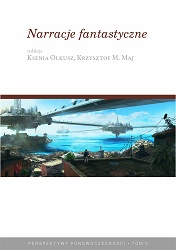"Koralina" Neila Gaimana w realizacjach teatru lalek w Polsce
Neil Gaiman’s Coraline in Polish Puppet Theatres Performances
Author(s): Maria Janus
Subject(s): Theatre, Dance, Performing Arts, Fine Arts / Performing Arts, Comparative Study of Literature, Theory of Literature
Published by: Ośrodek Badawczy Facta Ficta
Keywords: horro fiction;young adult horror;Neil Gaiman;Coraline;puppet theatre;
Summary/Abstract: Maria Janus focuses on theatrical adaptations of Neil Gaiman’s "Coraline" in Polish puppet theatre. The analysed performances were directed by Włodzimierz Fełenczak in Teatr Miniatura in Gdańsk with a stage design by Mikołaj Malesza (opening 2009) and in the Białostocki Teatr Lalek with a stage design by Joanna Braun (opening 2011) and directed by Karolina Maciejaszek in Teatr Pinokio in Łódź with a stage design by Anna Chadaj (opening 2013). In addition, the Author discusses the performance of Rozalinda, written and directed by Krystyna Jakóbczyk in the Teatr Dzieci Zagłębia in Będzin (opening 2012), which was inspired by Gaiman’s novel. Janus presents this performance in the context of copyrights and difficulties of obtaining licenses for use of texts written by popular authors (especially from the Anglo-Saxon region). The author compares the adaptations of Neil Gaiman’s novel written by Fełenczak, Maciejaszek and the translation of the novel’s narration by Jakóbczyk (theatrical situations and visual narration vs. the narration performed live on-stage). Maria Janus also highlights theatrical references from the novel considering meta-theatrical elements that enhance the performance. Janus compares theatrical media used in performances from Gdańsk, Białystok and Łódź with special consideration to the stage design and puppetry techniques. In the second part, the author focuses on the popularity of Neil Gaiman’s Coraline among theatrical directors despite little interest in horror fiction. Puppet theatres in Poland do not produce performances based on modern epic literature, especially those nbased on fantasy. Classical fairy-tales and modern dramaturgy containing fairy-tale motives are still more popular. Furthermore, Janus reflects on the possibility of a change of the herein discussed situation. She further refers to the arguments of Bruno Bettelheim, Stanisław Grzelecki and Katarzyna Slany considering young spectator benefits from the contact with theatrical representation of youth horror literature.
Book: Narracje fantastyczne
- Page Range: 209-221
- Page Count: 13
- Publication Year: 2017
- Language: Polish
- Content File-PDF

